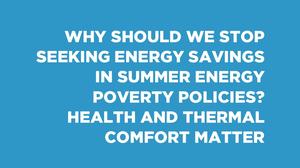Addressing energy poverty: Prioritizing indoor comfort and well-being

The policy brief created for the Cooltorise project addresses the issue of energy poverty, which affects numerous households across Europe. This situation manifests through both excessive energy expenditure and restrictive energy use. This dilemma often stems from low incomes, high energy prices, and poor energy efficiency in homes and appliances. Consequently, families may face deprivations in other essential areas such as food, education, or healthcare, or endure inadequate thermal comfort with severe health repercussions.
Current State of Energy Poverty in Europe
Data from the EU Statistics on Income and Living Conditions (EU-SILC) reveal that 9.3% of European households had difficulty adequately heating their homes in 2022. This problem is particularly acute in countries such as Bulgaria, Cyprus, Greece, Lithuania, Portugal, Spain, and Romania, where over 15% of households face this challenge. While winter heating issues are well-documented, summer cooling difficulties are less understood. The latest comprehensive data from 2012 indicated that 19% of the population found their homes too hot during the summer, a figure expected to worsen with rising temperatures and heatwaves.
The Impact of Summer Heat
In Portugal, the percentage of the population living in inadequately cooled homes has increased from 34% in 2012 to 38.3% in recent years. The penetration of air conditioning in Europe remains low, with less than 45 million units in residential buildings, equating to only nine units per 100 inhabitants. With increasing extreme heat events, the situation is bound to worsen, exacerbating health problems related to heat exposure.
The summer of 2022, characterized by record heat, saw over 61,000 heat-related deaths across Europe. Women and residents of southern countries such as Italy, Greece, Spain, and Portugal were particularly affected. While air conditioning can mitigate some health risks, it also contributes to increased emissions and exacerbates the urban heat island effect, suggesting the need for more sustainable cooling solutions.
Health Impacts of Energy Poverty
Energy poverty significantly affects health, particularly due to inadequate temperature regulation and poor housing conditions. Health problems related to heat include mental and nervous system disorders, cardiovascular, respiratory, and renal diseases, as well as complications for pregnant women and vulnerable groups such as the elderly, children, and outdoor workers.
Improving Assessments of Energy Poverty Projects
To effectively combat energy poverty, project assessments should shift focus from merely measuring energy savings to prioritizing indoor comfort and family well-being. This can be achieved through:
Improvement of Energy Certificates: Building energy certificates should incorporate indicators of the building's passive performance, which directly affect thermal comfort, alongside traditional metrics of energy consumption and CO2 emissions.
Development of a Health Certificate for Buildings: Similar to energy certificates, a health certificate should be established to assess factors such as air quality, material toxicity, and exposure to extreme temperatures, to directly reflect building characteristics that influence health and well-being.
Direct Temperature Monitoring: Programs should be established to monitor and measure indoor thermal comfort conditions, particularly in high-risk energy-poor households.
Assessment of Heat Resilience and Summer Well-being
Collecting comprehensive data on household cooling capacities and access to climate shelters is essential. Reintroducing well-being questions from previous surveys, such as the 2012 EU-SILC, will improve the understanding and addressing of summer energy poverty. Indicators such as "adequately cool housing during the summer" can provide valuable insights into the population's heat resilience.
Incorporating Well-being and Thermal Comfort into Policies
European energy poverty projects should prioritize increasing family well-being and thermal comfort, measured through indicators such as:
- Reducing energy demand and increasing hours spent in thermal comfort without air conditioning.
- Decreasing health risks associated with inadequate housing performance.
- Improving self-reported family comfort and financial stability.
- Reducing health issues related to energy poverty and extreme temperatures.
- Increasing access to climate shelters during the summer.
Enhancing Database Information to Address Health Inequalities and Energy Poverty
Databases should include detailed information on factors generating health inequalities, such as income, occupation type, housing quality, age, and gender. These data will help identify vulnerable households and inform effective policy measures. Additionally, health impact studies should be conducted to evaluate the relationship between reducing energy poverty and improvements in mental and physical health.
Addressing energy poverty requires a multifaceted approach that prioritizes indoor comfort and family well-being. By improving project assessments, incorporating well-being indicators, and enhancing data collection, policymakers can develop more effective strategies to combat energy poverty, ensuring sustainable living conditions and better health outcomes for all.
 457_allegato_931.pdf
457_allegato_931.pdf Print
Print
